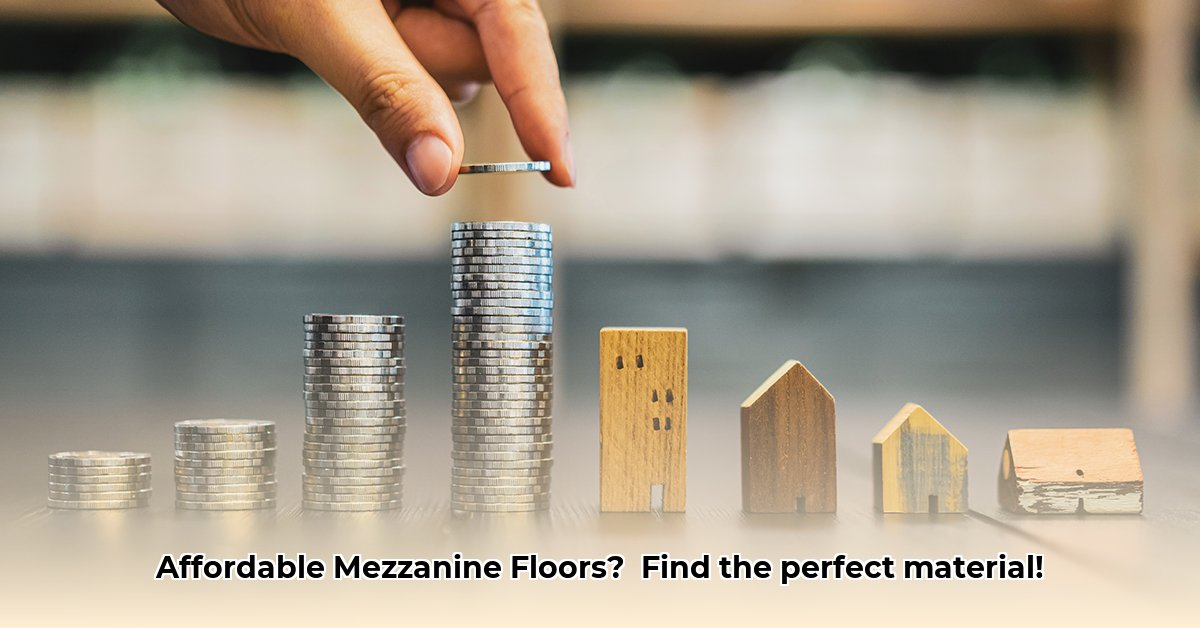Want to expand your building’s usable space without a major construction project? A mezzanine floor could be the perfect solution. But with various material options available, making the right choice can seem daunting. This guide helps you navigate the world of affordable mezzanine flooring, comparing AdvanTech, ResinDek, and concrete in terms of cost, durability, load capacity, and ideal applications. We’ll guide you through a step-by-step decision-making process to ensure you get the best value without compromising quality or safety. For more cost information, check out this mezzanine cost guide. Let’s find the perfect mezzanine floor to meet your needs and budget!
Selecting the Right Mezzanine Material: Durability and Applications
Selecting the right floor is crucial when building a mezzanine, impacting its longevity, functionality, and safety. This guide aims to simplify the process by comparing three popular and affordable options: AdvanTech, ResinDek, and concrete. By understanding the strengths and weaknesses of each material, including their load-bearing capabilities and ideal use cases, you can make an informed decision tailored to your specific needs and budget.
Comparing Mezzanine Material Options
Each material has specific strengths and weaknesses that directly influence its suitability for different applications. Understanding where each excels – and where it falls short – is critical to making the right choice.
AdvanTech: AdvanTech, a type of oriented strand board (OSB), is a relatively inexpensive option known for its strength and moisture resistance. However, its lower load capacity makes it unsuitable for extremely heavy items or industrial environments. It’s best suited for light-duty applications such as office spaces, retail displays, or light storage areas.
- Pros: Low initial cost, decent strength for its weight, resists moisture fairly well, and easy to install.
- Cons: Not suitable for heavy loads or high-impact environments, less durable than other options, may not withstand years of heavy use, and requires protection in consistently humid areas. Limited customization options.
ResinDek: Known for its versatility and durability, ResinDek strikes a balance between cost and performance. This engineered wood composite features a high-density core and a resin-infused surface, offering excellent load-bearing capacity and resistance to wear and tear. Its customizable nature allows you to tailor it to a variety of uses, from busy office spaces and retail environments to areas with automated machinery and moderate storage needs. ResinDek is a better choice for high-traffic areas than AdvanTech and offers better resistance to impacts and concentrated loads [1].
- Pros: Durable, offers many customization options (including finishes, textures, and coatings), handles moderate to high traffic, provides good impact resistance, and suitable for a variety of applications.
- Cons: More expensive than AdvanTech, its weight capacity isn’t as high as concrete, and can be susceptible to damage from prolonged exposure to standing water.
Concrete: Renowned for its exceptional strength and durability, concrete stands as the heavyweight champion of mezzanine floors. Ideal for storing heavy equipment, supporting machinery, or handling substantial loads, its strength comes at a higher cost (impacting the budget) and with design limitations, making it a less flexible material to work with. Concrete mezzanines also require specialized installation and can add significant weight to the building structure, requiring careful engineering considerations.
- Pros: Extremely strong, highest weight capacity, very durable, fire-resistant, and offers excellent sound dampening.
- Cons: The most expensive option, less design flexibility compared to others, complex and costly repairs, requires specialized installation, and adds significant weight to the building structure.
Load Capacity Considerations
Understanding the load capacity of each material is paramount for safety and functionality.
- AdvanTech: Suitable for light loads, typically up to 125 pounds per square foot (PSF).
- ResinDek: Offers a moderate load capacity, ranging from 125 to 250 PSF, depending on the specific product and installation.
- Concrete: Provides the highest load capacity, often exceeding 250 PSF, making it suitable for heavy-duty industrial applications.
Cost Breakdown
Prices for mezzanine flooring materials can fluctuate based on market conditions, supplier, and project scope. Always consult with contractors for current and accurate quotes. Here’s a general cost comparison to assist with initial budgeting.
| Material | Approximate Cost | Advantages | Disadvantages | Ideal Applications |
|---|---|---|---|---|
| AdvanTech | ~$73 per 4’x8′ sheet | Budget-friendly, reasonable strength, resists some moisture, easy to install | Not for heavy loads, less durable than others, requires protection in humid environments, limited customization options | Light office spaces, retail displays, light storage areas |
| ResinDek | ~$90 per 4’x8′ sheet | Durable, customizable, handles moderate to high traffic, good impact resistance, wide range of finishes and textures available | More costly than AdvanTech, weight limit is lower than concrete, susceptible to damage from prolonged exposure to standing water | Office spaces, retail environments, automated machinery areas, moderate storage needs, high-traffic areas |
| Concrete | ~$3.25 per sq ft | Incredibly strong, highest weight capacity, very durable, fire-resistant, excellent sound dampening | Most expensive option, less flexible design, challenging repairs, requires specialized installation, adds significant weight | Heavy equipment storage, machinery support, heavy-duty industrial applications, areas requiring fire resistance and sound dampening |
Sub-Flooring Considerations
Sub-flooring is a critical element in mezzanine construction, providing essential support and stability for the chosen flooring material. Selecting the right sub-flooring system (metal bars vs. metal decking) significantly affects the overall cost, load capacity, and structural integrity of the mezzanine. Metal decking provides a stronger, more evenly distributed base than individual bars, enhancing the safety and longevity of the structure.
Step-by-Step Decision-Making Process for Flooring
Choosing the right mezzanine flooring requires a clear and logical approach:
- Assess Your Needs: Determine the primary purpose of the mezzanine and the type of activities it will accommodate. Consider the weight and type of items to be stored, the amount of foot traffic expected, and any specific environmental factors (e.g., humidity, potential for spills). A light office setup requires less support than heavy machinery storage.
- Determine Load Requirements: Calculate the maximum load the mezzanine will need to support, including the weight of stored items, equipment, and personnel. Consult with a structural engineer to ensure accurate load calculations and compliance with building codes.
- Set a Realistic Budget: Establish a clear budget for the flooring component of the mezzanine project. This will help narrow down your choices and prevent overspending.
- Compare Materials: Weigh the pros and cons of each material carefully, considering your needs, budget, and load requirements. Evaluate factors such as durability, maintenance requirements, aesthetics, and customization options.
- Factor in Sub-Flooring Costs: Include the cost of steel decking or bars in your total estimate to account for structural integrity and safety. Consider the impact of sub-flooring on the overall height of the mezzanine and ensure adequate headroom.
- Gather Multiple Quotes: Obtain at least three quotes from reputable contractors, comparing not just material costs but also the overall project price, including installation, sub-flooring, and any necessary permits.
- Comply with Local Building Codes: Verify that your chosen materials and construction methods meet all local building codes and regulations. This is crucial for safety and avoiding future penalties. Consult with a qualified building inspector or engineer to ensure compliance.
Strategies to Mitigate Risks
Every mezzanine flooring material has potential drawbacks. Address these potential drawbacks with proper installation, maintenance, and preventative measures to minimize risks and extend the life and safety of your mezzanine. Regular inspections and partnering with reliable vendors who have a proven track record are recommended to fully mitigate the potential risks in mezzanine construction [1].
- AdvanTech: Protect from excessive moisture, avoid overloading, and inspect regularly for signs of damage or wear.
- ResinDek: Protect from prolonged exposure to standing water, avoid dropping heavy objects, and clean regularly to maintain the surface finish.
- Concrete: Prevent cracks by ensuring proper installation and load distribution, seal the surface to protect against stains and spills, and repair any damage promptly.
Importance of Regulatory Compliance
Always check and adhere to local building codes and regulations before starting construction. This may seem tedious, but skipping this step can lead to delays, fines, and safety hazards. Always ensure that your mezzanine floor meets all applicable OSHA guidelines related to safety [1]. Compliance with building codes ensures the structural integrity, fire safety, and accessibility of the mezzanine.
Maximizing Material Lifespan through Maintenance
Maintenance needs and lifespan vary significantly among mezzanine flooring materials. Implementing a proactive maintenance plan is essential for maximizing the lifespan and ensuring the continued safety and functionality of your mezzanine. Regular inspections and proactive maintenance can extend the life of your mezzanine, minimizing expensive repairs and ensuring long-term cost savings.
- AdvanTech: Inspect regularly for signs of water damage, warping, or delamination. Replace damaged panels promptly.
- ResinDek: Clean regularly with mild soap and water. Avoid harsh chemicals or abrasive cleaners. Repair any surface damage promptly.
- Concrete: Seal the surface
- Gray Kitchen Backsplash Ideas: Find Your Perfect Gray Tile - December 11, 2025
- Glass Wall Tiles For Bathroom: A Stylish, Durable Choice - December 10, 2025
- Glass Mosaic Kitchen Backsplash: Add Shimmer and Style - December 9, 2025









